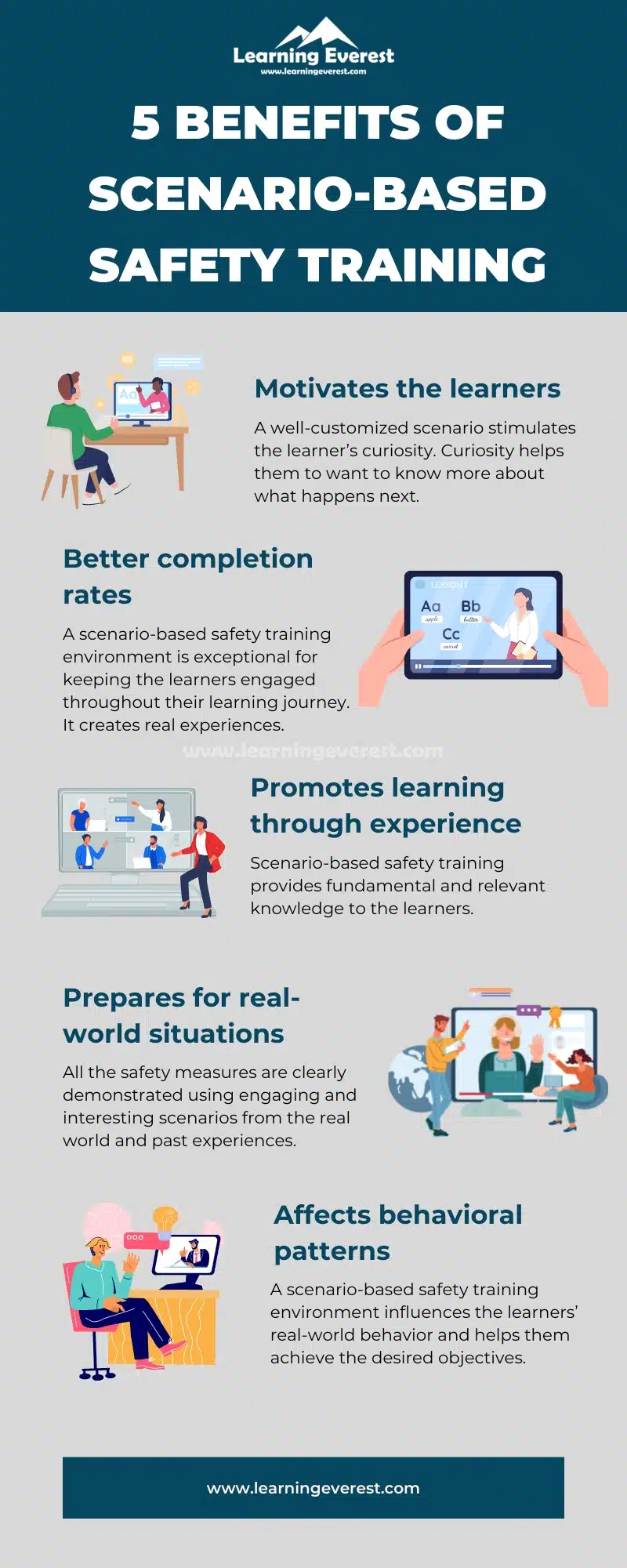What is Scenario-based training?
Scenario-based learning (SBL) creates an immersive learning and training environment where learners meet realistic work challenges and get realistic feedback as they progress since everything that happens reflects the learner’s choices. Scenarios help employees understand how the knowledge they receive can be applied in a working environment. The made-up scenarios can be related to a day-to-day workplace scenario, product or service sale to a customer, customer service experience or understanding, precise skill development, team-building exercise, teamwork, resolving common business issues, etc.
Scenarios allow you to enhance the interactivity of your training courses by providing experiential training to the employees. By putting the employees in real-world scenarios, you can train them in specific areas, improving their understanding of the scenario. A scenario-based method of learning or training can help employees immerse themselves in the course. With scenario-based safety training, you can make learning more engaging and exciting. This article will examine five effective and impactful benefits of scenario-based safety training.
Benefits of scenario-based training for safety
Here are some reasons why scenario-based safety training adds value to a learning journey:
- Motivates the learners: Safety training can be boring for most employees. But it is mandatory training. A well-customized scenario stimulates the learner’s curiosity. Curiosity helps them to want to know more about what happens next. The storytelling nature of scenario-based learning intrigues learners’ psychology. The scenarios can include several dialogues between employees from different departments. Learners found the approach very interesting. Therefore, naturally, this type of learning helps to generate a sense of motivation in the learners.
- Prepares the learners for real-world situations: Safety is an important concern involving employees from all departments in an organization. Scenario-based safety training is an effective way to teach your employees about safety aspects. Compared to traditional learning experiences, scenario-based learning is more likely to produce effective outcomes. The real-life scenarios are used to clarify the various aspects of safety, the suitable use of safety tools, the need to have all the proper techniques and tools in place, and so on. All the safety measures are clearly demonstrated using engaging and interesting scenarios from the real world and past experiences. Learners develop more extraordinary cognitive abilities than conventional learners. The learners exhibit better problem-solving skills, memory, higher retention power, and excellent attention control.
- Affects the thinking and behavioral patterns: A scenario-based safety training environment influences the learners’ real-world behavior and helps them achieve the desired objectives. You can use impactful scenario-based training strategies to provide engaging experiences to your learners. For that, scenario-based learning must be well designed, accounting for all the variables in the learner’s real life.
- Promotes learning through experience: Scenario-based safety training provides fundamental and relevant knowledge to the learners. It also generates essential skills such as problem-solving, critical thinking, teamwork, and communication.
- Better completion rates: A scenario-based safety training environment is exceptional for keeping the learners engaged throughout their learning journey. It creates real experiences. You can effectively use scenarios to provide certain skill training to the employees. The interesting scenario provides more fun and engaging experiences for the employees, making the training content more interesting, memorable, and engaging. By leveraging audio-visual techniques as a reality, scenario-based learning transforms how learners used to learn hitherto and makes it an easily graspable form of eLearning. The scenarios developed using animated characters, multi-colored icons, and animated graphics provide an immersive experience for the learners.
To sum it up, scenario-based safety training is highly engaging and realistic, and the learners develop an emotional attachment to the learning process. It is shifting the method of learning and training. While promoting learning through experience, scenario-based learning prepares them to face real-world challenges.
Infographics
Conclusion
No scenario-based safety training course can replace real experience. Still, learners will be at least able to make some mistakes and learn from them in a simulated environment without the risk of actual physical harm or other serious consequences. Scenario-based safety training helps employees acquire skills and manage similar circumstances more effectively. This type of training helps reinforce knowledge and build better retention. It also helps employees sharpen their skills in critical thinking and decision-making. Moreover, scenario-based training builds confidence and proactivity, thus helping you become a better individual, personally and professionally. It helps accelerate career growth by equipping you with adaptability and transferable skills.
Frequently Asked Questions (FAQs)
What is scenario-based learning?
A scenario is essentially a story. Scenario-based learning (SBL) creates an immersive learning and training environment where learners meet realistic work challenges and get realistic feedback as they progress since everything that happens reflects the learner’s choices.
How do you start a scenario?
Identifying the target audience is the first step in creating any scenario-based learning course. Knowing the audience helps create a relevant, engaging, and effective situation that allows the learners to use their knowledge in real-world situations.
What makes a good scenario?
Constructing a scenario is not only about framing an engaging story; you must also ensure it remains instructionally effective. To do so, create a believable and relatable character. The character in the scenario must inspire the learners to change their behavior and learn new skills.






